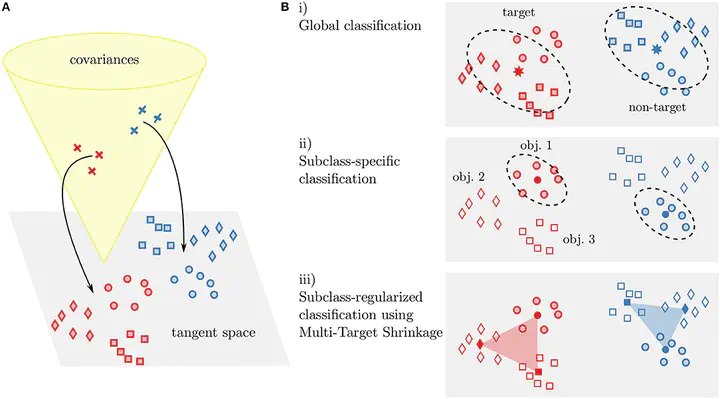Subclass-Aware Decoding of Word-Evoked Auditory Event-Related Potential Data

Brain-computer interface (BCI) protocols, which make use of an event-related potential protocol typically provide different external stimuli to users and record, if one of these stimuli was perceived as an attended target stimulus, while the other stimuli should have been ignored as so-called non-target stimuli. The machine learning methods used for classifiying target- from non-target ERP responses of the recorded brain signals like EEG have to solve a two-class problem, and most model classes indeed assume a Gaussian distribution of ERP features for both, the target and non-target class of stimuli. Depending on the experimental protocol, however, the non-target class is usually made up from multiple sub-classes while the target class indeed is homogeneous. An example from BCI-based spelling protocol, assuming sequential highlighting of single symbols: the non-target class of a letter selection step consists of all possible letters to choose from (via a graphical user interface) which currently are ignored, i.e. not selected, while the target class consists of a single symbol only.
For specifically heterogeneous visual ERP dataset, the benefit of treating subclasses explicitly has been shown [1]. It is unclear, however, if also auditory ERP protocols like the one used for the rehabilitation training of stroke patients with aphasia [2] could benefit from this.
[1] Kolkhorst et al., 2020. A Robust Screen-Free Brain-Computer Interface for Robotic Object Selection. Frontiers in Robotics and AI, Vol. 7. https://doi.org/10.3389/frobt.2020.00038
Task
This thesis investigates subclass-aware decoding of word-evoked auditory event-related potential data, with the goal to provide a more efficient classification approach for future patients with aphasia who train with the BCI-based rehabilitation system.
[2] Sosulski, J., & Tangermann, M. (2022). Introducing block-Toeplitz covariance matrices to remaster linear discriminant analysis for event-related potential brain–computer interfaces. Journal of Neural Engineering, 19(6), 066001. https://doi.org/10.1088/1741-2552/ac9c98
Skills required
- Machine learning
- Very strong mathematical background and intuition
- Good programming skills in Python (familiarity with numpy, sklearn, MNE)
- Experience in ERP data analysis (e.g., from BKI323 course)